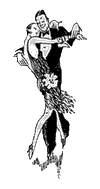 |
ROUND DANCING — CHOREOGRAPHED BALLROOMEDUCATIONAL ARTICLESMAJOR SECTIONS: Figures | Articles | Links | Alph. Index | Search | Home |
|
|
Dance Smallby Harold & Meredith Sears If we were to suggest that dancers should sometimes think about doing less—a smaller step, a more subtle arm motion, a more subdued lunge … would it seem as though we were wimping out? On TV, we watch these improbably tall, willowy dancers reaching out on long legs and sprinting from one corner of the floor to the opposite in just a few, heart-stopping movements. These displays are fabulous show, but not for everyday. You and I need to tame our most extreme enthusiasms—think controlled rather than wild, small and subtle rather than huge and flamboyant. Such a strategy will benefit the joints and muscles of both you and your partner. It will be a comfort to other dancers on the floor. It is a survival strategy for the long run. Dancing small and controlled is a cozy campfire that yields up many comforts. Giving full vent to your enthusiasms is more like a forest fire—impressive; it'll draw a crowd. But it leaves everyone shaken.When you begin a Link Rock in Jive, don't step apart to arm's length. Take a small step back, keeping your lead foot under your body and your center of gravity balanced over the ball of your foot—not the heel. Instead of coming to the end of your outstretched arm, "the end of your rope," you'll be able to maintain a cushioned elasticity in a flexed elbow. In butterfly position, rock apart only so that arms are half extended, not fully extended in front of you. In this way, we still have flex and give. Rocking apart all the way is like bottoming out on your car's springs—no give left and it brings you down with a thud. In a Foxtrot, you might Roll Across to a Lunge. Don't take loping steps with a view to covering ground. Do that and you will end far apart, your rear end stuck out, reaching back toward your partner, and only able to touch fingertips. Instead, take a medium step/spin, medium step/spin. Now you will end the Roll close enough to take your partner's hand and have flex in the arms to permit a comfortable lunge apart. A Rumba Time Step with Explosion can contain either destructive or controlled arm work, and our goal is to dance smoothly. Don't flail your arms up, out, or around, but describe the celebratory arc deliberately and with your partner in mind. In a Waltz, you might be in closed position and about to turn right. Men, don't push her with your left hand. Such a push will move her to the right, but it is an isolated and therefore harsh movement. You are straightening your elbow and moving your hand, but your shoulder and the rest of your body are hardly involved. Isolated movements are almost always sharp, unexpected, and uncomfortable. Instead, involve your whole torso: rise a little in the knees, rotate your whole frame so that the left shoulder moves forward, and with it, the elbow and hand. At the same time, the right shoulder comes back, and the result is lots of gentle signals to your partner, not just one sharp one. So often in dance, when you do something big, you end up doing something to your partner. When you are able to stay smaller and more controlled, you end up doing something with your partner. Dancing with your partner is surely our goal.
This article was published in the Washington Area Square Dancers Cooperative Association (WASCA) Calls 'n' Cues, 49-5:9, 1/2009.
If you would like to read other articles on dance position, technique, styling, and specific dance rhythms, you may visit the article TOC. Past DRDC Educational Articles archived here. Go beyond this site. Find other references on our Sources and Links pages.
|
 |
|
|
Page last revised